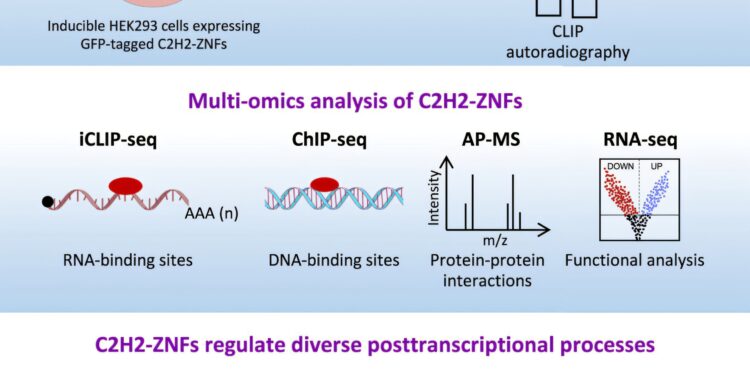Graphical summary. Credit: Molecular cell (2024). DOI: 10.1016/j.molcel.2024.08.037
Researchers at the University of Toronto have shown that an important class of DNA-binding factors can also bind RNA, thereby regulating gene expression through various mechanisms. The study significantly expands our understanding of the functions of these proteins and establishes them as a new class of RNA-binding proteins.
C2H2 zinc finger proteins constitute the largest group of DNA-binding factors for transcription, the process of copying genetic information from DNA to messenger RNA (mRNA). As there are over 700 proteins in this group, most are not well understood. The few that have benefited from targeted research have been studied for their role in transcription.
“We looked at 150 members of the C2H2 zinc finger protein family,” said Syed Nabeel-Shah, first author of the study and recent Ph.D. degree in molecular genetics at the Donnelly Center for Cellular and Biomolecular Research at the University of Toronto.
“Although this family of proteins has been studied in the context of transcription factors, a handful of them were also found to bind RNA by the time I began my doctoral studies. J I was curious if RNA binding was a general property of these proteins…which turned out to be the case.”
The study was recently published in the journal Molecular cell.
“We know the DNA binding sites for about 120 of the C2H2 zinc finger proteins we studied,” said Nabeel-Shah, who received the Donnelly Center’s 2024 Dissertation Award for her research studies on the RNA-binding functions of zinc finger proteins.
“We suspected that if the proteins also bound to RNA, the DNA and RNA binding sites might be linked. Typically, they were not, because the proteins targeted the promoter regions of DNA and the three main untranslated regions of mRNA.”
The research team discovered that C2H2 zinc finger proteins regulate various post-transcriptional processes that modify mRNA, which serves as a template for protein production. These processes include splicing the precursor mRNA to remove non-coding regions, controlling mRNA length via mechanisms called cleavage and polyadenylation, and modifying the mRNA after transcription via enzymes via a process called modification m6A.
In a complementary study published in Genome biologythe team investigated how a specific zinc finger protein regulates m6A modification levels, building on their recent findings in Molecular cell. Researchers previously found that one of the most studied C2H2 zinc finger transcription factors, called SP1, regulates alternative cleavage and polyadenylation of mRNAs.
“Our team identified a gap in knowledge about the RNA-binding capabilities of C2H2 zinc finger proteins,” said Jack Greenblatt, principal investigator of the study and professor of molecular genetics at the Donnelly Center and the Temerty Faculty of Medicine.
“Researchers have focused on DNA binding because of its link to disease, but there is much unknown information about RNA binding by these proteins and its implications for gene expression Although we have mapped the RNA binding sites for a number of zinc C2H2 finger proteins, we are only just beginning to scratch the surface of studying their functions.
More information:
Syed Nabeel-Shah et al, C2H2-zinc finger transcription factors bind RNA and function in various post-transcriptional regulatory processes, Molecular cell (2024). DOI: 10.1016/j.molcel.2024.08.037
Syed Nabeel-Shah et al, Recruitment of m6A/m6Am FTO demethylase to target RNAs by the telomeric zinc finger protein ZBTB48, Genome biology (2024). DOI: 10.1186/s13059-024-03392-7
Provided by University of Toronto
Quote: DNA-binding C2H2 zinc finger proteins also regulate RNA processing, researchers find (October 17, 2024) retrieved October 17, 2024 from
This document is subject to copyright. Except for fair use for private study or research purposes, no part may be reproduced without written permission. The content is provided for informational purposes only.



